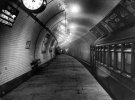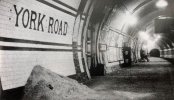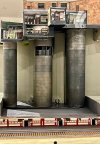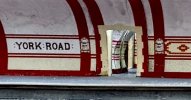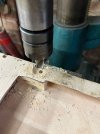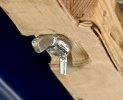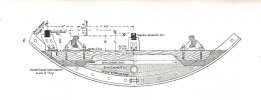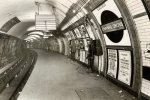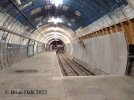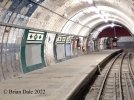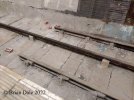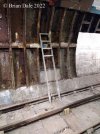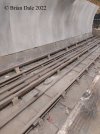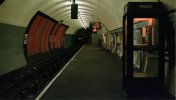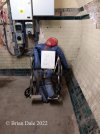Tim Watson
Western Thunderer
After some fairly steady and tricky work the station platforms for York Road are now sketched in. The 100% accurate artwork for the tiles is courtesy of Douglas Rose, author of the superb and very rare ‘Tiles of the Unexpected, Underground’. The patterns were printed on fairly stiff 250gsm silk-faced card.
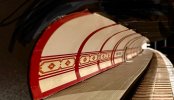
The platform surface is currently unattached, just sitting passively in this photo.
The whole project is complicated by the compound horizontal curvature of the station platform and the tube structure itself. The main supports consist of 2mm MDF ribs cut using the Model Railway Club’s laser cutting facility: these are strategically attached to 0.8mm thick ply sub-base.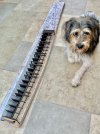
Pip is guarding the board here: last time he worked on YR he was but a puppy.
The tiled card was rolled on a soft cushion with a polished steel rod. It would probably have worked better with Piccadilly Line moquette, rather than Routemaster.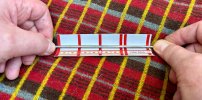
The adverse curvature of the station platforms is accommodated by breaking the tile run either side of the crossway entrances. These entrance sections were touched in with a red marker pen to avoid unsightly dodgy edges.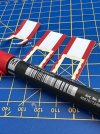
The area above the dado was painted white, just in case there were any gaps showing between the card sections.
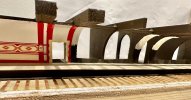
The 700mm long fully tiled walls do look rather pretty (if I do say so myself) and bring a station back to life that closed 91 years ago.

There is a lot more work to do…
Tim

The platform surface is currently unattached, just sitting passively in this photo.
The whole project is complicated by the compound horizontal curvature of the station platform and the tube structure itself. The main supports consist of 2mm MDF ribs cut using the Model Railway Club’s laser cutting facility: these are strategically attached to 0.8mm thick ply sub-base.

Pip is guarding the board here: last time he worked on YR he was but a puppy.
The tiled card was rolled on a soft cushion with a polished steel rod. It would probably have worked better with Piccadilly Line moquette, rather than Routemaster.

The adverse curvature of the station platforms is accommodated by breaking the tile run either side of the crossway entrances. These entrance sections were touched in with a red marker pen to avoid unsightly dodgy edges.

The area above the dado was painted white, just in case there were any gaps showing between the card sections.

The 700mm long fully tiled walls do look rather pretty (if I do say so myself) and bring a station back to life that closed 91 years ago.

There is a lot more work to do…
Tim

